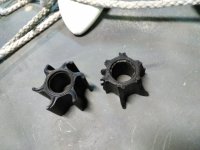Hello Mercruiser owners with Engine Mounted raw water Pumps OR members here that have a real understanding of or have worked on or installed these systems. I'm looking for some real world experience/input please. I have a 73 Mako23 I/O with a carburated, electric fuel pump, raw water cooled, reman Michigan Motorz (300+hrs now) 4.3 w/A1G2 outdrive all pretty much OEM. I use the boat early and late season (read, in freezing temps) and recently had an outing interrupted by a failed (lower unit mounted) impeller, along with spending the rest of winter basically rebuilding or replacing my motor I'm considering switching the system to Engine Mounted raw water Pump. Re; it seems to me that in an event not unlike what my crew and I went through this past weekend that if the pump had been inside the boat that I would have had fighting chance to not burn my motor up while saving life and limb. In a very topical internet search it looks as though the parts/system exists, is used in some boats, wouldn't be too difficult to install (I have a deep mechanical background and in-house machine and welding dept)...I'm open to any yeah/neah input regarding the idea. Aside; 1 thing I couldn't find definitive info on is whether the EMP system needs the lower unit pump to lift the water initially OR does the EMP alone have enough pull to draw the water all the way up to it's inlet from the LU. Again, any input appreciated, thanks in advance.

- Shop
-
Main Menu Find The Right Fit
-
-
Slide Anchor Box Anchors Shop Now

-
Back Fishing
-
View All
- Fishing Rods
- Fishing Reels
- Fishing Rod & Reel Combos
- Fishing Tools & Tackle Boxes
- Fishing Line
- Fly Fishing
- Fishing Bait & Fishing Lures
- Fishing Rod Holders & Storage Racks
- Fish Finders, Sounders & Sonar
- Trolling Motors
- Fishing Nets
- Fishing Downriggers & Acessories
- Fishing Outriggers & Acessories
- Fishing Kayaks
- Fish Cleaning Tables
-
-
Minn Kota Riptide Terrova 80 Trolling Motor w/i-Pilot & Bluetooth Shop Trolling Motors

-
SportsStuff Great Big Marble Shop Tubes

-
Big Jon Honda 5hp Outboard Shop Outboards

-
Lexington High Back Reclining Helm Seat Shop Helm Seats

-
Kuuma Stow n Go BBQ Shop Now

-
Slide Anchor Box Anchors Shop Now

-
Back Electrical
-
View All
- Boat Wiring & Cable
- Marine Batteries & Accessories
- Marine DC Power Plugs & Sockets
- Marine Electrical Meters
- Boat Lights
- Marine Electrical Panels & Circuit Breakers
- Power Packs & Jump Starters
- Marine Solar Power Accessories
- Marine Electrical Terminals
- Marine Fuse Blocks & Terminal Blocks
- Marine Switches
- Shore Power & AC Distribution
-
-
ProMariner ProNautic Battery Charger Shop Marine Battery Chargers

-
Lowrance Hook2-4 GPS Bullet Skimmer Shop GPS Chartplotter and Fish Finder Combo

-
Boston Whaler, 1972-1993, Boat Gel Coat - Spectrum Color Find your boats Gel Coat Match

-
Rule 1500 GPH Automatic Bilge Pump Shop Bilge Pumps

-
Back Trailering
-
SeaSense Trailer Winch Shop Trailer Winches

-
Seadog Stainless Steel Cup Holder Shop Drink Holders

-
Slide Anchor Box Anchors Shop Now

-
- Boats for Sale
- Community
-







